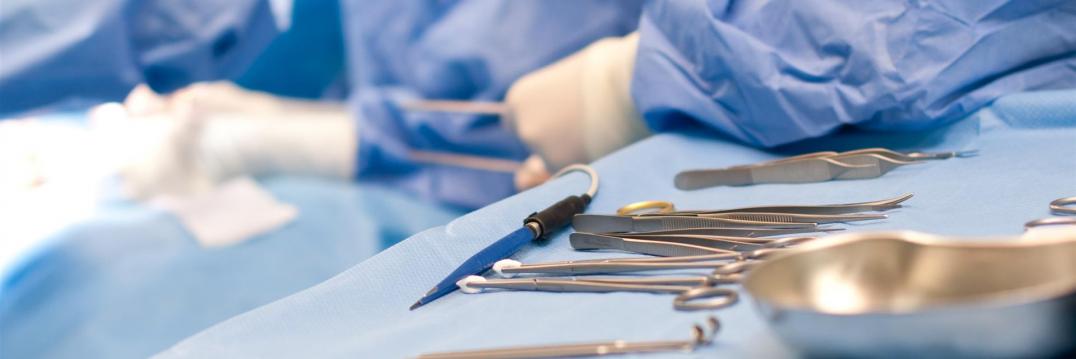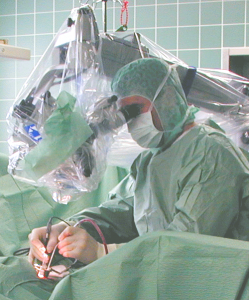surgical tools
Neurosurgery involves the surgical treatment of diseases, disorders, injuries and malformations of the entire central and peripheral nervous system. In addition to general surgical techniques, microsurgery is an essential principle of neurosurgical operation. Since the development of the surgical microscope and the associated micro-instruments, this surgical technique has been constantly refined. It is an indispensable part of today's neurosurgical surgical routine, as the surgical field often has only a few millimeters of expansion and contains highly sensitive, potentially vital structures.
microscope
The surgical microscope creates optimal environmental conditions for microsurgery.
It visually enlarges the operating field in all three dimensions for the observer and ideally illuminates it. Microscopes of today's generation allow a joint direct view of the surgical field by the surgeon and his assistant, as well as an indirect viewing through photo and video recording. This ensures a precise centering of the optical system on the surgical field. Due to the extensive technology and the required stability, the microscopes have a relatively high weight. Thanks to a sophisticated balancing system, the finest adjustments for the surgeon are possible without any effort. Future, superintelligent microscopes allow the import of image data from CT and MRI examinations, tissue analyzes by using appropriate light spectra and the automatic active control of the surgical field.
Instruments
The microsurgical surgical technique is intended to allow the depiction, removal, severance or reunification of tissue structures, often with small intrinsic sizes, in a confined space while preserving adjacent sensitive structures. It is impossible for the surgeon to reach the surgical target area by hand. Therefore take different fine instruments, such. As forceps, tweezers, suckers, probes, and scissors, etc. the required functions and the transmission of tactile properties.
job profile
Training as a neurosurgeon is one of the most elaborate of medicine. After 6 years of study, the training follows, which is at least 6 years at a hospital. Here, the treatment of brain diseases such as bleeding, brain tumors and spinal disorders is learned.
Unlike other disciplines, the neurosurgeon learns from the beginning of his training on spine surgery. Here, the neurosurgeon offers a whole range of treatment options, from conservative measures to various surgical options, he has a bundle of treatment options available. It is of inestimable advantage that the neurosurgeon as a professional diagnostician and therapist is arranged between a neurologist and an orthopedist. This also shows the specialty, namely all diseases of the musculoskeletal system in close relation to the nervous system, most clearly in the spine, where spinal cord, nerve root, intervertebral discs and bony vertebrae and the ligaments of the spinal motion segment are in close proximity to each other and interact in many ways and thus causing one of the biggest problems of our modern society, namely complaints in the area of the spine, ranging from the cervical spine to the lumbar spine, also known as lumbago, lumbago or sciatica.
In the diagnosis, the neurosurgeon orthopedic examination techniques and the sophisticated, neurological examination techniques are good, so that he can rapidly gain a targeted overview of the symptoms and possibly failures (paralysis, numbness, etc.) and corresponding, targeted further investigations, by electrophysiology (diameter from nerves and muscles) to very specific radiological examinations, in particular computer tomography and magnetic resonance tomography. If the diagnosis of nerve root compression by a herniated disc or a bony Wirbelkanaleinengung once made, which is associated with back pain, neck-back pain, arm pain or leg pain in the sense z. B. a classic lumbago, can specifically start the therapy. As a rule, conservative measures (medication intake, physiotherapy) are treated by means of a gradual therapy scheme, if not done by the family physician in advance. In the absence of improvement, infiltration and injections, introduced into the spinal column or the nerve roots, can lead to a marked relief of the symptoms or even to a cure, so that an operative measure may possibly even be unnecessary. Even modern catheter techniques and back pain cryosurgical measures for cold denervation of vertebral joints are outpatient possible, as well as z. As laser disc surgery or endoscopic surgical techniques. However, even a large number of patients can not be cured of their severe pain alone, so that further microsurgical-surgical measures may be necessary. Again, the experienced vertebral surgeon neurosurgeons many special processing techniques are available. Bony compressive bone pits can be removed with special diamond high-speed milling, the finest instruments for the removal of herniated discs or even state-of-the-art locking materials such as titanium or peek (especially modern medical plastic) materials are available for the reconstruction of spinal segments and stiffening In case of microstructure disorders in the area of the spinal column etc. These procedures are usually performed on an outpatient or short-term basis (3-4 days inpatient stay).
A second major task of the neurosurgeon is nerve surgery. Here is a gentle and rapid surgical treatment of bottleneck syndromes on an outpatient basis. As the known carpal tunnel syndrome, in which the median nerve is trapped in the wrist, to call. A pinched nerve in the area of the elbow (sulcus ulnaris syndrome), which can also be relieved or even relocated on an outpatient basis, is one of the more common syndromes that the neurosurgeon especially treats surgically when conservative measures have failed.
The so-called Morton metatarsalgia (a painful irritation of one or more nerves between the toes with tingling and pain in the area of the forefoot) belongs to the area of responsibility of the neurosurgeon, this disease is often not recognized and only by a neurosurgeon who sees this disease more often ultimately diagnosed and treated.
Another occurring and often unknown disease is the so-called tarsal tunnel syndrome, a pinching of a nerve in the area of the ankle. Also for pain in the area of the thigh, the front and outside with very painful discomfort, caused by irritation of a nerve in the area of the inguinal ligament, the neurosurgeon is the professionally competent diagnostician and therapist.
Very often, such above-mentioned nerve diseases are misinterpreted or not recognized and are only specifically addressed, diagnosed and treated by the neurosurgeon who is versed in the field of neurology and the movement axis organ. It should not go unmentioned that the modern neurosurgeon continues to be involved in the diagnosis and follow-up and transmission of patients with brain disorders, but that does not make up the bulk of practicing neurosurgeons.
Another great therapy picture of the neurosurgeon is the chronic pain and in this case the targeted neurosurgical pain therapy, in addition to drug therapies including opiates, morphine medications, a variety of infiltration techniques and the implantation of electrical spinal cord stimulation devices and drug pumps, which release morphine into the spinal canal via a catheter, given a very specific field of therapy. It is here that the neurosurgeon can make full use of his vast experience of diagnostics, knowledge of diseases and their relation to the nervous system in connection with the possible conservative and operative measures.


